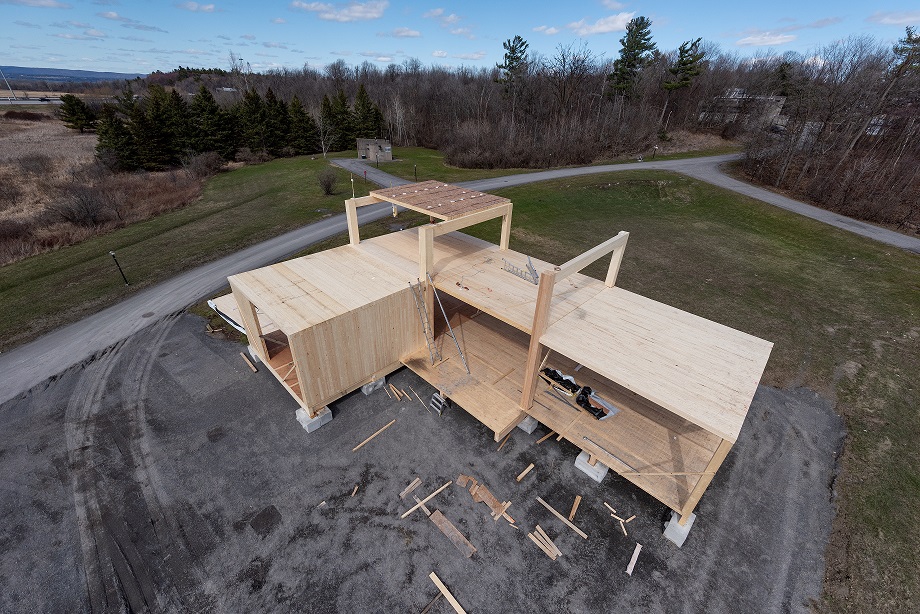

Code-Prescribed Solution for Noncombustible Building (Occupied Residential Space)
The purpose of this test is to provide a baseline scenario for comparison purposes, representing an acceptable solution of the National Building Code (e.g., a code-prescribed solution) permitted for a high building of noncombustible construction.
Combustible interior finishes, including wall and ceiling finishes, are permitted by the NBC in a building of noncombustible construction. To date, research testing for mass timber has used noncombustible finishes as a baseline for comparison. This test will simulate the permitted combustible finishes in a noncombustible building for comparison to mass timber in Test #2.
Residential fuel load. Three of the four interior walls will be finished with 25 mm (1”) thick plywood. The ceiling will be finished with 25 mm (1”) fire-retardant-treated plywood. The floor and all structural elements will be protected and will not contribute to the fire.
After flashover, the fire will be relatively large and severe until the fuel contents and combustible finishes are consumed. With no remaining fuel, the fire will then decay relatively rapidly.

Exposed Mass Timber Construction (Occupied Residential Space)
The purpose of this test is to provide a demonstration of the performance of exposed mass timber in a realistic occupied residential scenario for direct comparison with Test 1, the code-prescribed solution for noncombustible construction.
The side-by-side comparison of an identical space with identical fuel load and ventilation conditions in Test 1 will allow a performance comparison between a fire compartment in a building of noncombustible construction and one with exposed mass timber construction.
Residential fuel load. Exposed mass timber ceiling, beam, and columns.
After flashover, the fire will be relatively large and severe until the fuel contents are consumed. With only the mass timber remaining as fuel, and with a protective char layer, the fire is expected to decay.

Construction Site Fire Scenario (Garbage Can Scenario)
The purpose of the test is to demonstrate the performance of exposed mass timber during a construction site fire (severe garbage can fire).
Construction site fires are a concern to fire and building officials, insurers, and builders. To date, there has been limited testing to demonstrate the performance of mass timber in the case of a fire during construction.
Severe garbage can fire. Floor, ceiling and one wall exposed mass timber. Other compartment walls protected with gypsum.
The test will demonstrate that fire will decay as the garbage can contents are consumed.

Construction Site Fire Scenario
The purpose of this test is to provide a demonstration of the performance of exposed mass timber in a realistic but severe construction site scenario to add to the information learned from Test 3. This test is intended to demonstrate a more severe fire that may occur during construction, where a larger quantity of combustible materials is present. The fuel load will consist of wood cribs in addition to light wood framing installed in a typical residential suite configuration that has not yet been protected by gypsum board.
Construction site fires are a concern to fire and building officials, insurers, and builders. To date, there has been limited testing to demonstrate the performance of mass timber in the case of a fire during construction.
Large fuel load consisting of wood cribs, unprotected light wood framing (typical of a residential suite), and exposed mass timber ceiling, floor, beams and columns. Intended to simulate a very severe fire scenario during construction.
Once the fuel load (cribs and framing) are consumed, the fire is expected to decay.

Completed Building Scenario: Open Office Floor Plan
The majority of exposed mass timber compartment fire tests conducted to date have been simulating residential occupancies. This test is intended to demonstrate fire performance and dynamics in a typical occupied open-office space in a mass timber building. Therefore, the space is much larger than previous tests with a larger footprint as well as a higher floor to ceiling height.
Smaller fire compartments with lower ventilation are considered to result in worst-case conditions with respect to fire severity in general. As such, research testing to date has focused on this condition. This test will provide insight into the fire dynamics in a larger space, typical of those often seen in modern mass timber buildings.
The fuel load simulates a typical office layout, including mocked-up cubicle-style workstations simulated using wood products as a fuel. The mass timber ceiling, beams, and columns, as well as a CLT wall, will be exposed. With four 7.3 m x 7.3 m bays, this will be the largest mass timber research fire test conducted in North America to date.
Flame-spread throughout the space is expected to be relatively fast, reaching flashover in a short time. Once the fuel load is consumed, the fire is expected to decay.
